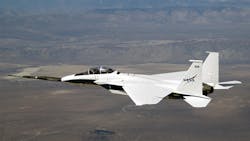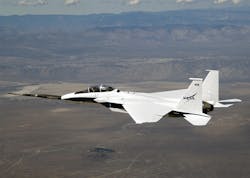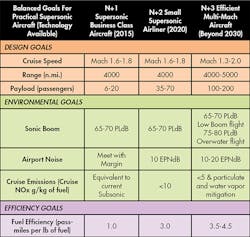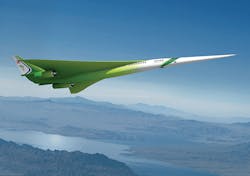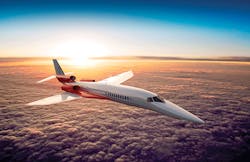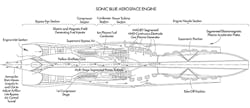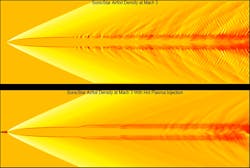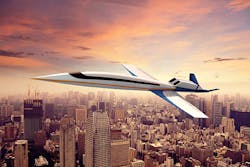Supersonic Flight: Overcoming the Sonic Boom
The last commercial supersonic flight was the Concorde in 2003. The Concorde flew commercially starting in 1976, with seating for up to 128 passengers. Its cruising speed was 1,354 mph (2,179 km/h) with a Mach number of 2.04. Before that, the jet regularly flew from Singapore to London, New York to London, and from New York to Mexico City. But on its route to Mexico, it would have to fly at subsonic speeds while crossing over Florida because supersonic flight over land was—and still is—either banned or highly regulated in several countries, including the United States. To make supersonic flight legal for over-land routes, universities, private companies, and NASA are working to solve the problem of sonic booms (see "The Basics of Sonic Booms").
This file type includes high resolution graphics and schematics when applicable.
In Search of a Quieter Boom
During the days of the Concorde, many complained of the property damage created by sonic booms, let alone the noise pollution that many found intolerable. Between 1956 and 1968, over 38,000 claims were filed against the U.S. Air Force for damage wrought by sonic booms. As a result, since 1971, the Federal Aviation Administration (FAA) has prohibited supersonic flight over land. Also influencing that ban were concerns about the effects on the environment, including ozone depletion and climate change.
In 2001, NASA started the Shaped Sonic Boom Experiment to analyze sonic booms. They modified the fuselage of a Northrop F-5E Tiger II in an attempt to lower the effects of sonic booms during test flights. The nose of the F-5E was removed and replaced with a larger, longer version. The fairing under the fuselage was also lengthened and deepened.
The modified F-5E or Shaped Sonic Boom Demonstrator flew in 2003, and from that point, NASA took 1,300 sonic-boom measurements from various ground sensors. NASA engineers confirmed that the modifications led to an 18% reduction in initial pressure impulse and booms were an average of 4.7 decibels quieter compared to an unmodified F-5E.
NASA then moved on to the Sonic Boom Mitigation Project in 2005, which led to the introduction of the Quiet Spike. For this project, engineers at NASA’s Dryden Flight Research Center mounted a 24-ft. lance-like spike to the nose of an F-15B. The spike created three small shock waves that would parallel each other as they traveled to the ground. The smaller shock waves produce less sound compared to typical shock waves.
In 2007, the Quiet Spike F-15 reached supersonic flight with a Mach number high of 1.8. Test results confirmed predictions of the formation of smaller shock waves before the creation of a loud sonic boom, caused by rising pressure due to air coming in contact with the unmodified body of the F-15.
NASA’s next step was to hold its first Fundamental Aeronautics Conference in 2007, where it planned its next stages of supersonic research. (The N+ technology table shows NASA’s plan for the next generation of supersonic aircraft.)
In 2014, Lockheed Martin and the Boeing Co. began projects to introduce “N+2” technology under the NASA High Speed Project. The Lockheed design puts an engine under each wing in a traditional configuration with a third centerline engine above the wing. Boeing’s aircraft, on the other hand, has two top-mounted engines. Both aircraft share features that have successfully been used on supersonic jets, such as needle-like nose, sleek fuselage, and delta or highly swept wings. But engine placement will be crucial to both designs, according to Peter Coen, manager of NASA’s High Speed Project.
“[I]f we mount the engines in a conventional manner, we need to carefully tailor the shape of the wing to diffuse the shock waves,” says Coen. “If we mount the engines above the wing, the shock wave can be directed upward and not affect the ground signature.”
Both Boeing and Lockheed Martin constructed scale models of their designs for wind-tunnel testing at NASA’s Ames and Glenn Research Centers. Tests checked performance at Mach numbers ranging from 0.25 to 1.8, at different angles of attack, and with different nacelles or engine housings. Test results showed that the placement of Boeing’s aircraft nacelles on top of the wing had negligible effect on booms. Lockheed’s aircraft, which had the more traditional nacelle mounting location under the wing, also had a typical boom profile.
Current and Future Research Studies
The latest NASA research comes from the American Institute of Aeronautics and Astronautics, which held its first Sonic Boom Prediction Workshop in January 2014. The workshop’s purpose was to assess the current technology for predicting sonic-boom propagation. The presentations consisted of the latest techniques in computational fluid dynamic software to help design and build better aircraft bodies and wings. This could lead to more defined supersonic flight envelopes that pilots could adhere to, thereby creating fewer and smaller booms.
Researchers demonstrated that supersonic airfoils can be constructed to induce passive laminar flow control (LFC). This reduces or eliminates the turbulent crossflow on wings that produces shock waves. Consequently, the goal of this research is to create LFC on the wing that would, in effect, mean the wing’s leading edge would remain subsonic during supersonic flight. The absence of a supersonic leading edge would reduce shock waves and minimize flow disturbances, producing more stable and efficient flight.
Research performed at MIT’s Laboratory for Aviation and the Environment, with NASA’s help, is analyzing the effects of sonic booms on the environment. The purpose is to understand how high-altitude emissions caused by supersonic aircraft affect the atmosphere. They will monitor emissions from biofuel combustion in stratospheric conditions, study their impact on ozone depletion, and try to determine how they may cause higher UV levels in the atmosphere and on the ground.
Commercial Prospects
Aerion Corp. has been working on reducing sonic booms since 2002, when it introduced its Supersonic Natural Laminar Flow technology. Aerion designed a wing with supersonic LFC, which reduces drag by 50% over the wing. Laminar flow wings are thin and smooth so as to not trip the boundary layer and enter turbulent flow. Aerion’s wing design is unswept but tapered with a relatively sharp leading edge, and features a modified bi-convex airfoil with the upper and lower surfaces slightly curved. Aerion will use this wing on its Supersonic Aerion AS2.
The wing carries high-lift flaps that give the plane low approach and landing speeds comparable to large subsonic business jets. The flaps also let the plane land at relatively low angles of attack where visibility is good. The wing cuts drag by 20% on the total airframe to boost efficiency.
The Aerion plan is to push the FAA to allow supersonic flights over land by relying on low Mach numbers, which translates into small or negligible sonic booms. Aerion plans to exploit the Mach cutoff, which is a region of the atmosphere that blocks sonic booms from being heard on the ground. According to Doug Nichols, Aerion CEO, normal atmospheric phenomena, mainly temperature and wind, bounce or refract sonic booms upward at 5,000 feet above the ground. And exploiting the Mach cutoff should be more effective than any low-boom features on the aircraft
Avionics onboard the AS2 will use atmospheric data to calculate the supersonic speeds that create sonic booms that would get refracted. “[T]he Aerion AS2 is designed to fly efficiently at supersonic and subsonic speeds. Under current U.S. regulations, the aircraft would cruise at about .95 Mach over the U.S., where supersonic flight is prohibited. However, the aircraft can operate at speeds up to about Mach 1.2 without producing a boom on the ground,” says Nichols.
Hypermach Aerospace LTD., U.K. introduced a plan in 2011 to reduce sonic booms by using electromagnetic reduction technology on its Sonic Star aircraft. The engines, designed by Hypermach’s sister company, Sonic Blue Aerospace Inc., are called Supersonic Magnetic Advanced Generation Jet Electric Turbine (S-MAGJET). The engine combines a jet-fuel-powered turbine, superconducting electric power and propulsion generation, and a magnetic-power flux field system with an ion plasma annular injection combustor. The engine generates 30.5 megawatts (MW) of electric power through its superconducting electric turbine ring generator, as well as 54,700 lb. of thrust. Most of the electricity goes to power the bypass fan, compressor, and the turbine. The excess electricity, 7 MW, flows to electrical subsystems such as landing gear, avionics, and redundant systems.
The magnetic ion plasma annular injection combustor also receives power from the turbine ring generator. Plasma is generated by applying a direct-current electric field between two electrodes. The plasma coil generator provides electricity coming from connections that feed into the injector body. This creates an electric charge and ionizes the fuel as it’s injected into the combustor chamber. The magnetic field controls and stabilizes the combustion process, allowing for complete combustion of the atomized ionized fuel.
The Sonic Star reduces sonic boom by injecting plasma ahead of the shock wave. It uses plasma actuators built into the aircraft and powered by the S-MAGJET engines to ionize the air as it passes from forward to aft. The plasma airfoil gives the high pressure an escape route to travel around the aircraft instead of coming in direct contact, avoiding the creation of drag and shock waves.
Does Speed Outweigh Cost?
Airlines retired the Concorde due to lack of profits and rising maintenance and fuel costs. With the higher gas prices and decline of air travel in 2001, the Concorde could no longer be justified as a means of only business and first-class travel. Pricing for future supersonic airliners, according to Vik Kachoria, CEO of Spike Aerospace, would be similar to the average price of a private commercial jet, which is around 100 million dollars. Spike Aerospace is currently working on its supersonic jet, the S-512.
Fuel efficiency, a larger market, more routes (such as those over land), and eliminating sonic booms are all important for making supersonic flight viable. Affordable supersonic flights over land would open the airline industry to new possibilities and push development to the next stage. Vik Kachoria put it well saying “...now that there are planes, have you ever seen anyone take a steamship to London…as soon as you have [travel], which is faster, safer, [and] better, you’ll be using that.”
This file type includes high resolution graphics and schematics when applicable.
